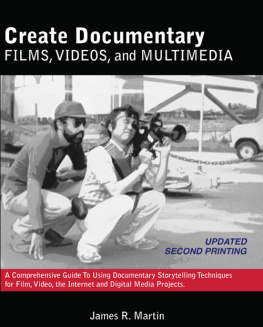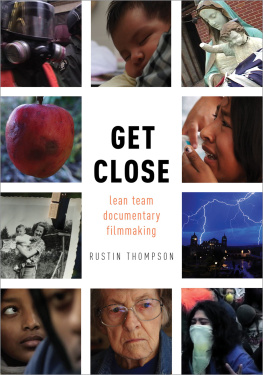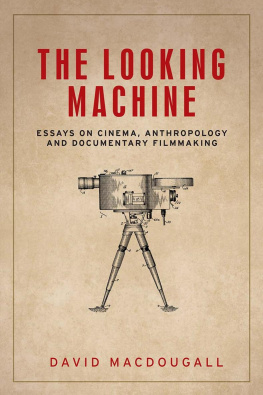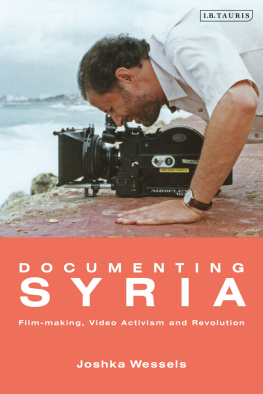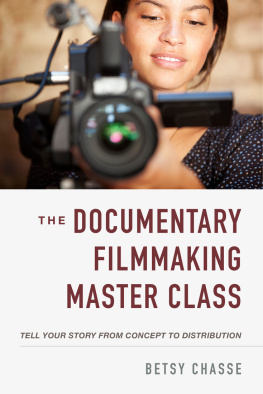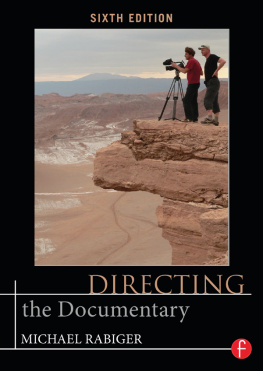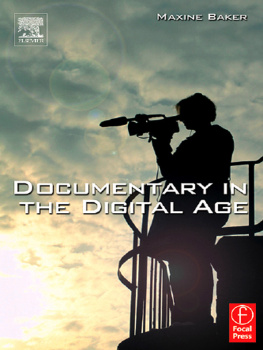First published 2012 by Left Coast Press, Inc
Published 2016 by Routledge
2 Park Square, Milton Park, Abingdon, Oxon OX14 4RN
711 Third Avenue, New York, NY 10017, USA
Routledge is an imprint of the Taylor & Francis Group, an informa business
Copyright 2012 Taylor & Francis.
All rights reserved. No part of this book may be reprinted or reproduced or utilised in any form or by any electronic, mechanical, or other means, now known or hereafter invented, including photocopying and recording, or in any information storage or retrieval system, without permission in writing from the publishers.
Notice:
Product or corporate names may be trademarks or registered trademarks, and are used only for identification and explanation without intent to infringe.
Library of Congress Cataloging-in-Publication Data:
Pepe, Peter, 1952-
Documentary filmmaking for archaeologists / Peter Pepe and Joseph W. Zarzynski.
pages cm
Includes bibliographical references and index.
ISBN 978-1-61132-201-9 (hardback : alkaline paper)
ISBN 978-1-61132-202-6 (paperback : alkaline paper)
ISBN (invalid) 978-1-61132-203-3 (institutional ebook)
ISBN (invalid) 978-1-61132-686-4 (consumer ebook)
1. Motion pictures in archaeology. 2. ArchaeologyMethodology. 3. Documentary filmsProduction and direction. I. Zarzynski, Joseph W. II. Title.
CC85.P47 2012
070.1'8--dc23
201203751
ISBN 978-1-61132-201-9 hardback
ISBN 978-1-61132-202-6 paperback
T HIS BOOK IS AN OUTGROWTH OF a workshop that we first taught in January 2008 at the Society for Historical Archaeologys 41st Annual Conference on Historical and Underwater Archaeology held in Albuquerque, New Mexico. Entitled An Archaeologists Guide to Documentary Filmmaking, the one-day workshop was well received, and we have held it at several other Society for Historical Archaeology (SHA) annual conferences and at other venues, too. Without that initial SHA workshop, this book probably would not have come into being. So, we want to thank Karen Hutchinson, Executive Director for the SHA, and our initial SHA workshop coordinator, Jamie C. Brandon, an archaeologist and anthropologist at Southern Arkansas University. Both had the vision to accept our workshop proposal.
Furthermore, this book would not have been possible without the patience, enthusiasm, and understanding of our publisher, Mitch Allen. Mitch is a regular attendee at major archaeology and anthropology conferences around the country. At these conferences, he can generally be found in the conference book room where he both promotes the science of archaeology and displays the many fine books that his company publishes. When we first proposed our book idea to him, he promptly opened up a line of communication that we often exercised, and which culminated in Mitch offering us the book deal. It has been a pleasure working with him and his talented staff at Left Coast Press, Inc.
There are several other people that need to be acknowledged, too. Joseph Pepe, Peters son and business partner at Pepe Productions, is an enthusiastic member of the digital natives of the world, and thus he clearly understands the magnitude of the digital revolution and the emergence of social media as a means to promote the genre of documentary filmmaking. Joseph frequently shares his vast knowledge of video filmmaking and website design which we put to excellent use when writing those sections in our book. John Whitesel, a dear friend and an incredible animator and computer technician, also provided valuable information, about the somewhat esoteric world of computer animation. Unfortunately, the week before the initial draft of this book went to Left Coast Press, Inc., John passed away from cancer. His animation and computer-generated images have imbued our archaeology documentaries with a tour de force quality that has been one of the hallmarks of Pepe Productions videos. Our thanks likewise go out to Kathleen McCormick, a consummate museum collections manager at the St. Augustine Lighthouse & Museum (St. Augustine, Florida), and her husband, Doug Bowen, an old-school animator and artist. The couple loaned us several books on Eadweard Muybridge, Winsor McCay, and the history of animation that we consulted frequently when researching our book. James P. Delgado, a NOAA underwater archaeologist and administrator, kindly provided us with detailed information on the television series, The Sea Hunters, which we included in our book. Vincent J. Capone (Black Laser Learning), a side-scan sonar specialist who uses video productions to teach his highly technical craft, shared his expertise in producing training DVDs on remote sensing, which we described in one chapter in the book. We also want to thank Lori Toledo and Pat Meaney for being our sounding boards throughout this endeavor; Pat likewise was helpful doing some fact checking for us. Thanks are due as well to all the groups and individuals that were supportive of our underwater archaeology documentaries. These include Bateaux Below, Inc. (Russell P. Bellico, Bob Benway, Vincent J. Capone, Terry Crandall, and John Farrell), the Lighthouse Archaeological Maritime Program (Chuck Meide, Samuel Turner, Brendan Burke, Christine Mavrick, and Starr Cox), the Wiawaka Holiday House staff, the Fund for Lake George, Inc., the Lake George Mirror (Lake George, New York), The Chronicle (Glens Falls, New York), The Saratogian (Saratoga Springs, New York), the Glens Falls Post-Star (Glens Falls, New York), the Albany Times Union (Albany, New York), The Daily Gazette (Schenectady, New York), Kip Grant, Kathy Abbass, Sam Bowser, Steven C. Resler, Paul Cornell, Mark L. Peckham, Alan Bauder, Christina Rieth, Charles Vandrei, John Wimbush, David Starbuck, Garry Kozak, Martin Klein, Ralph Wilbanks, Clive Cussler, Elizabeth Miller, Kathy Fleming (St. Augustine Lighthouse & Museum), the 2009 Lighthouse Archaeological Maritime Program Field School, Lisa and Tony Hall, Paul Post, Chris Carola, and Lee Coleman. Furthermore, we wish to thank those people who provided the images used in this book and who are duly credited in the photo captions. Also, we appreciate the work of Mitch Allen and Julie M. Schablitsky for their review and comments on the manuscript of this book. Finally, we would be remiss if we did not thank the numerous people who purchased our underwater archaeology-related DVD documentaries and also those folks who viewed the productions during public screenings. In so doing, they gave us confidence in our documentarian skills that eventually translated into our writing of this book.








